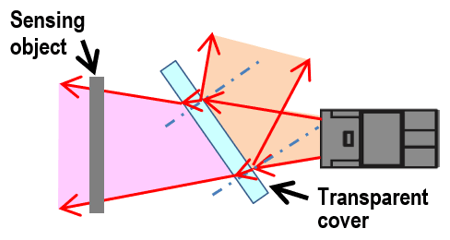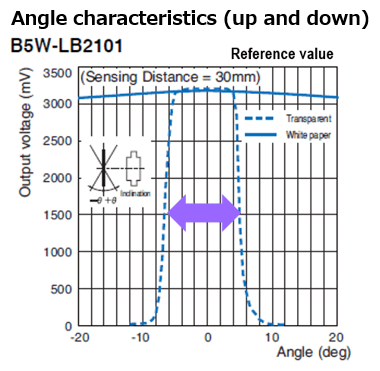Is it possible to put a transparent cover in front of light convergent reflective type Optical Sensor B5W-LB for dust/water prevention?
ID: FAQE40038E
update:
Answer
It is possible. When a transparent cover plate is installed in front of the Optical Sensor, however, it is necessary to take measures to prevent reflected light from the cover plate from entering the sensor.
Explanation
When attaching a transparent cover on the light convergent reflective type sensor B5W-LB series for water/dust prevention purposes, the plate must be closely attached to the sensing surface of the sensor. When a transparent cover plate is installed apart from the sensor, reflected light from the transparent plate may result in the sensor receiving light at all times.
Even if a transparent cover plate is installed in contact with the sensing surface of the sensor, reflected light on the inner and outer surfaces of the transparent plate itself (see below) enters the sensor.
Designing the plate to be as thin as possible reduces this light input. When evaluating this with the digital output model, make sure that the sensor does not receive light even if the cover plate is slightly away from the sensor. If the sensor detects even a small amount of the light, it means that there is not sufficient margin in the threshold and you must select the analog output model. Check the output voltages when there is a sensing object through the cover and only the cover without any object, and set the optimum threshold.

Quick tips
In the case that a transparent cover is required to be located away from the sensor, check if it’s possible to tilt the cover.
This design can eliminate the reflected light from inside and outside surfaces of the cover to the sensor. For the installation angle, refer to angle characteristics of the datasheet. In this case as well, check the output voltages when there is a sensing object through the cover and only the cover without any object, and set the optimum threshold.
In addition, receiving light intensity may significantly vary when the condition of the cover surface is compromised, due to scratches, water drops, dust or contamination. Therefore, we recommend that you conduct evaluation tests that take into account the changes including those mentioned above after you start using the equipment.



| Product category | Sensors Light Convergent Reflective Sensors/Diffuse Reflective Sensors |
|---|---|
| Classification | Usage, Applications |
| Related keywords |
|